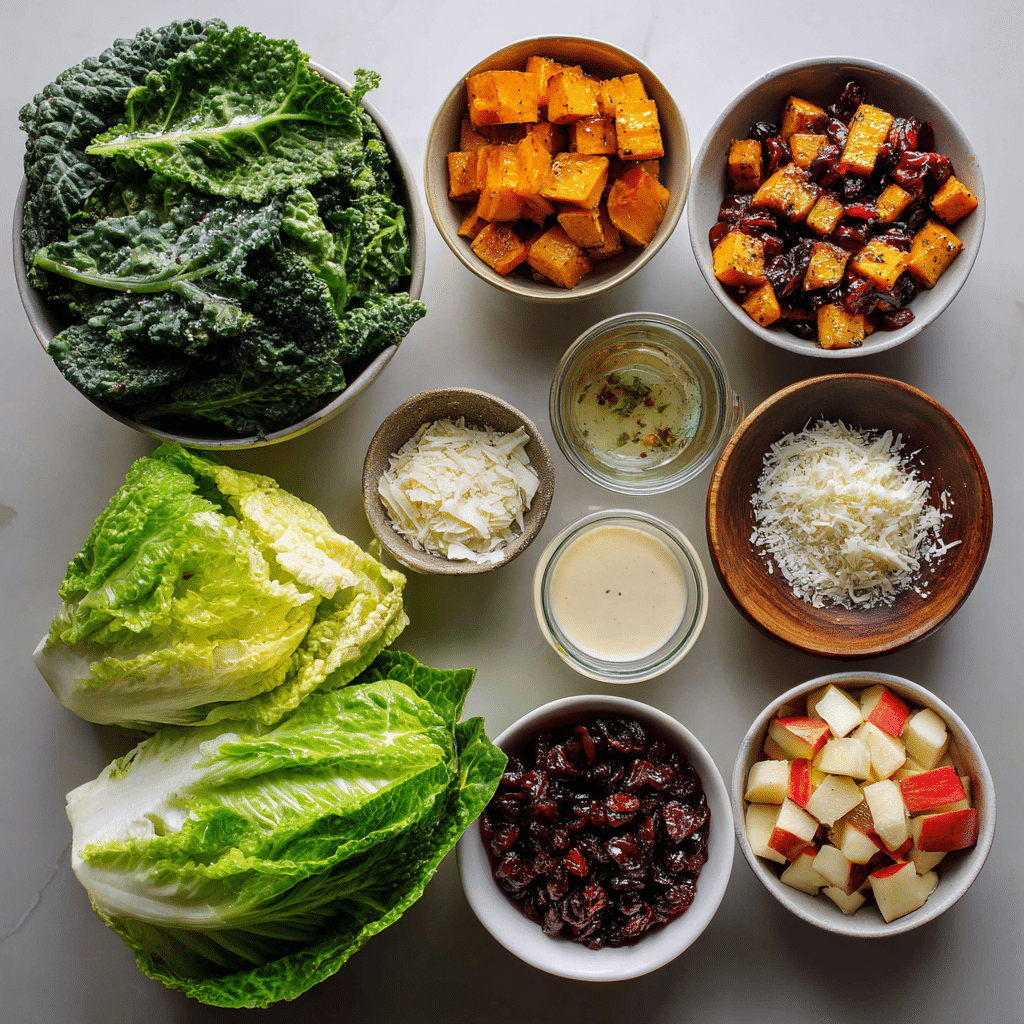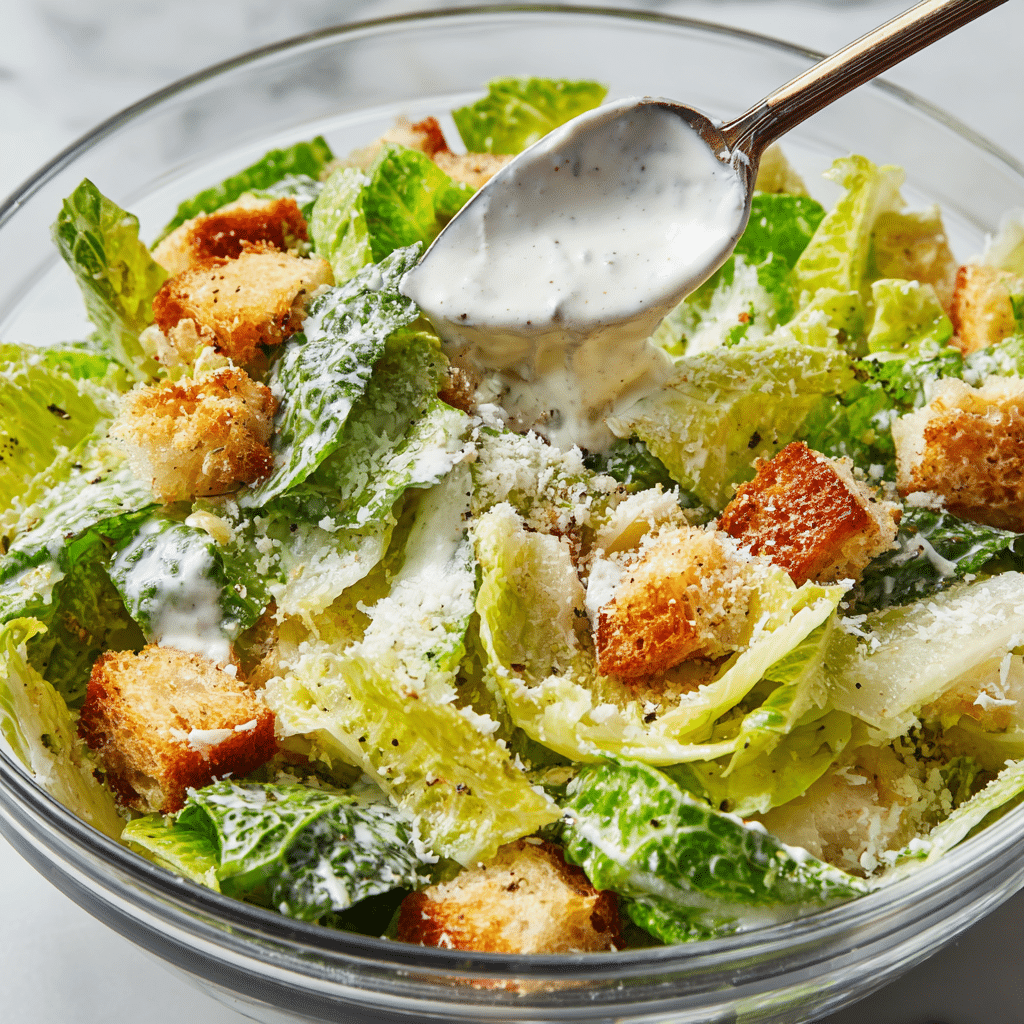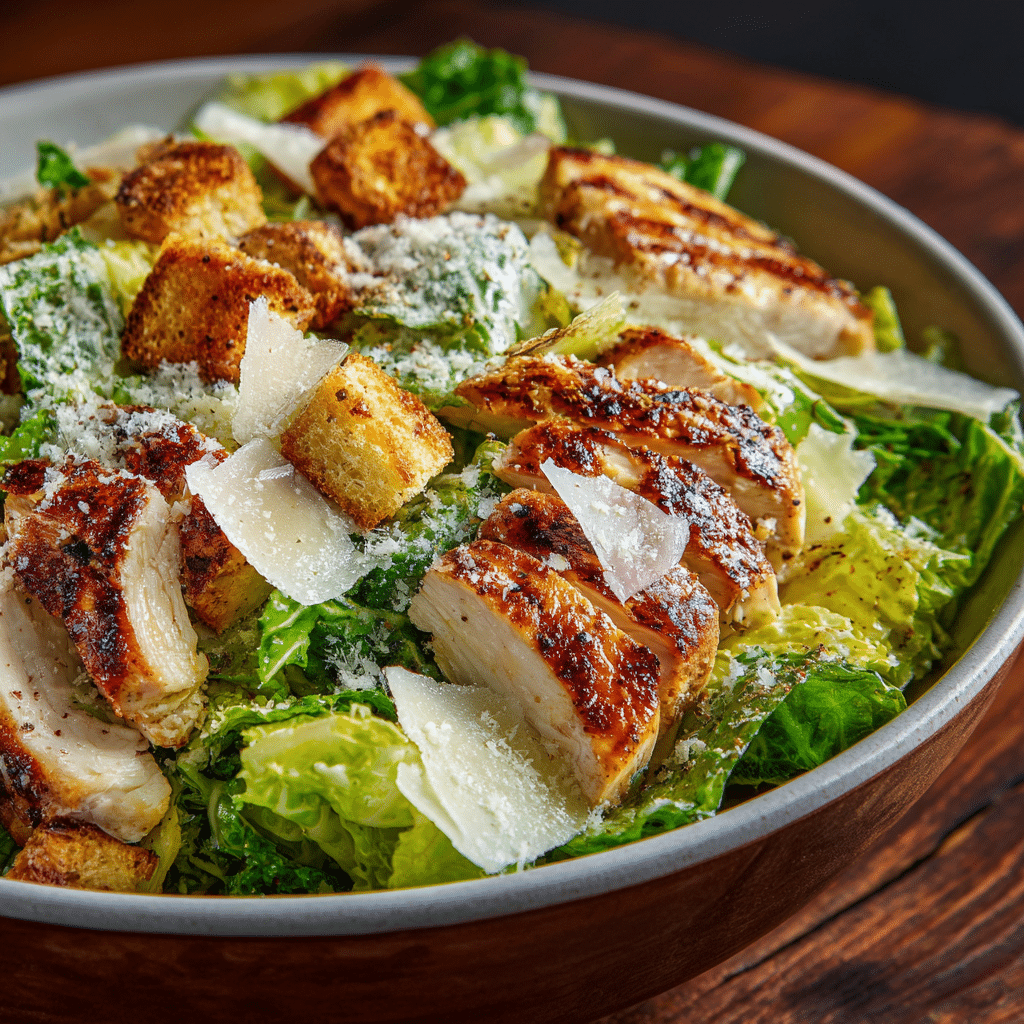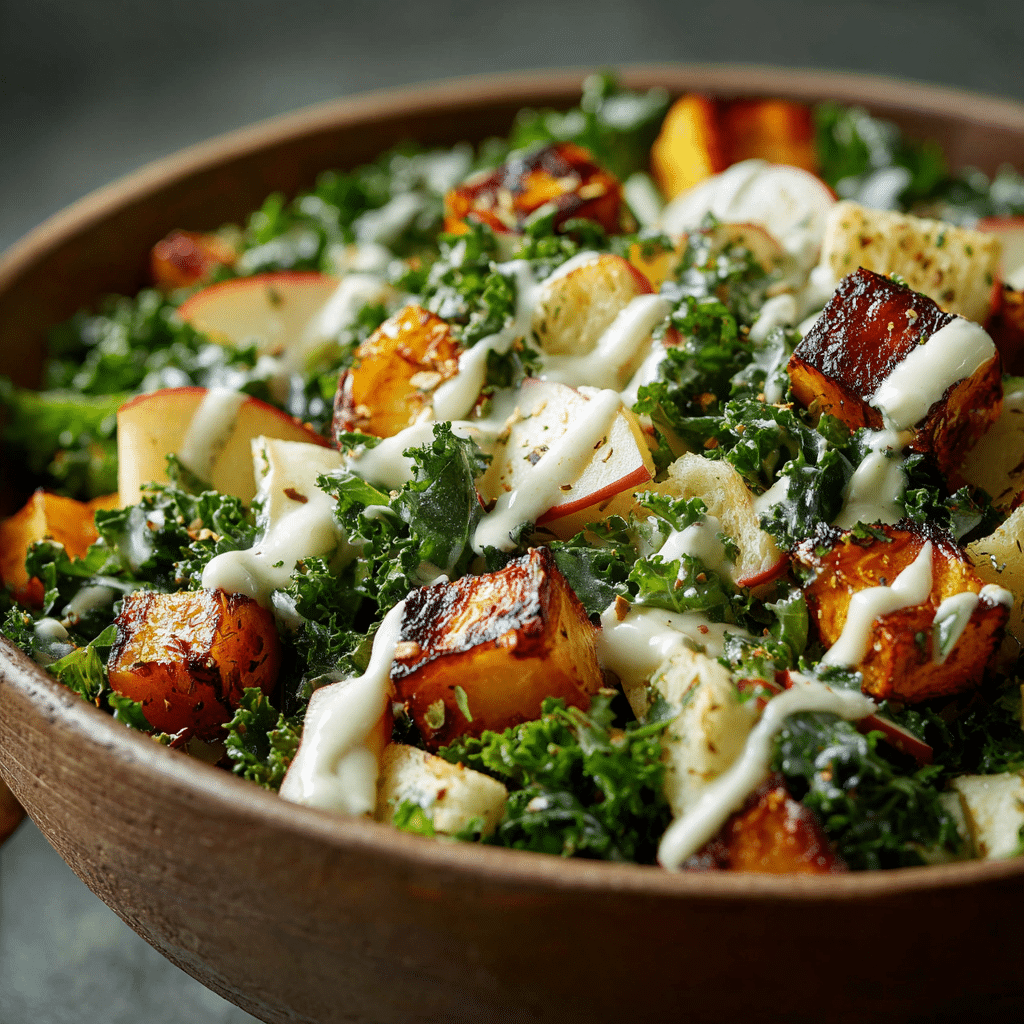The classic Caesar salad has been a beloved staple for decades crisp romaine, creamy dressing, crunchy croutons, and that signature tangy bite. But when fall arrives, it’s time to give this timeless dish a cozy, seasonal makeover. Enter the Harvest Caesar Salad a colorful blend of crisp greens, roasted fall vegetables, toasted nuts, and a rich Caesar dressing that ties it all together.
This salad brings the warmth of autumn to your plate. It’s hearty enough to serve as a main course yet light enough for a side dish at any meal. Whether you’re hosting a fall dinner party or just craving something fresh and wholesome, this salad delivers layers of texture, flavor, and nutrition.
Want more fall salad inspiration? Check out our fall salad recipes for more delicious, seasonal ideas.
Why Harvest Caesar Salad Is the Perfect Seasonal Upgrade
The Evolution of the Classic Caesar Salad
Traditional Caesar salad was created in the 1920s by restaurateur Caesar Cardini and originally featured romaine lettuce, Parmesan cheese, croutons, and a garlicky anchovy dressing. Over the years, it’s become a restaurant favorite but the harvest version takes it to another level by adding roasted seasonal produce, fresh herbs, and a hint of sweetness.
This creative twist enhances both the flavor and nutritional value of the classic recipe. By blending fall ingredients like roasted butternut squash, apples, cranberries, or candied pecans, you turn a simple Caesar into a vibrant, satisfying salad perfect for cooler months.
Why the Harvest Version Is Perfect for Fall
Autumn is all about comforting flavors, warm colors, and earthy textures and this salad embodies them all. The sweetness of roasted vegetables pairs beautifully with the tangy Caesar dressing, while crunchy toppings add contrast to the creamy base.
What makes it even better? The Harvest Caesar Salad can be easily customized. Add grilled chicken for protein, roasted chickpeas for crunch, or even pumpkin seeds for a nutty twist. It’s simple, stunning, and full of the wholesome goodness that makes fall cooking so rewarding.
Essential Ingredients for a Harvest Caesar Salad

The Base: Crisp Greens and Autumn Produce
Every great salad starts with fresh, vibrant greens, and the Harvest Caesar Salad is no exception. While traditional Caesar salads rely solely on romaine lettuce, this fall-inspired version benefits from a more diverse mix of textures and flavors.
Try combining:
- Romaine lettuce – for that signature Caesar crunch.
- Kale – adds heartiness and a nutritional boost.
- Arugula or spinach – offers a peppery or mild touch for balance.
Next, incorporate fall-inspired produce that brings color, sweetness, and warmth to your plate:
- Roasted butternut squash or sweet potatoes – soft, caramelized, and slightly sweet.
- Crisp apples or pears – for a juicy, fresh crunch.
- Dried cranberries or pomegranate seeds – to add tartness and visual appeal.
This colorful mix not only looks beautiful but also transforms a simple Caesar into a more filling, nutrient-packed dish perfect for autumn.
The Toppings That Make It Special
No Caesar salad is complete without its signature toppings, but the harvest twist gives you room to get creative. Instead of plain croutons, try:
- Maple-roasted pecans or candied walnuts – for a sweet, nutty crunch.
- Pumpkin seeds (pepitas) – a protein-rich, fall-inspired substitute for croutons.
- Shaved Parmesan or aged Gouda – adds salty, nutty flavor to balance the sweetness of the fruit.
For extra heartiness, add grilled chicken, roasted turkey, or crispy chickpeas. The combination of warm and cool elements makes this salad irresistible and satisfying enough for a full meal.
Together, these ingredients create a Harvest Caesar Salad that’s bursting with seasonal flavor, vibrant color, and the perfect mix of textures.
The Secret to a Good Caesar Salad
Balancing Textures and Flavors
The secret to a truly great Caesar salad and especially a harvest version is all about balance. Each bite should offer a combination of crunch, creaminess, saltiness, and freshness. That means every ingredient needs to play its part.
- Crunch: Romaine lettuce, kale, and toppings like nuts or roasted chickpeas give that satisfying bite.
- Creaminess: The dressing and cheese provide a luscious, rich texture that ties everything together.
- Saltiness: Parmesan cheese and anchovies (if you include them) enhance depth and umami flavor.
- Freshness: Apples, citrus zest, or arugula brighten the overall taste.
This balance ensures that no element overpowers another, giving your Harvest Caesar Salad the perfect harmony of taste and texture.
Using Quality Ingredients
A Caesar salad may seem simple, but the quality of your ingredients makes all the difference. Here’s what separates an average salad from an unforgettable one:
- Use fresh, crisp greens. Wilted lettuce or kale ruins the texture wash, dry, and chill them before assembling.
- Opt for freshly grated cheese. Skip pre-shredded varieties, which can taste waxy or bland.
- Make your own dressing. Homemade Caesar dressing, whether classic or lightened-up, always outshines bottled versions.
- Add texture intentionally. Toasted nuts, roasted vegetables, or seeds create depth and contrast.
A good Caesar salad is never just tossed together it’s crafted with care and attention to every flavor and detail. When you apply these principles, your Harvest Caesar Salad will taste like it came straight from a restaurant kitchen.
What Makes Restaurant Caesar Salad So Good

The Professional Techniques That Elevate Flavor
Ever wonder why restaurant Caesar salads always taste better than the ones you make at home? It’s not just the presentationit’s the technique and attention to detail. Chefs know that the key lies in layering textures and seasoning properly.
- Fresh, cold greens: Restaurants always chill their lettuce before tossing. Cold greens hold dressing better and stay crisp longer.
- Emulsified dressing: The best Caesar dressings are blended until smooth and creamy, allowing every leaf to be evenly coated without becoming soggy.
- Balanced salt and acid: A squeeze of lemon or a splash of vinegar cuts through the richness of the dressing, while just enough salt brings all the flavors to life.
- Tossed to order: Instead of drowning the salad in dressing, chefs toss it gently in small batches right before serving to preserve the perfect texture.
How to Recreate Restaurant Quality at Home
The good news? You can easily make your Harvest Caesar Salad taste just as amazing as a restaurant version with a few simple adjustments:
- Use homemade or high-quality dressing. A good Caesar dressing makes all the difference creamy, tangy, and garlicky with a hint of umami.
- Massage hearty greens. If you’re using kale or spinach, gently massage the leaves with a drizzle of olive oil to soften them without wilting.
- Add warmth. Restaurants often serve salads with freshly grilled chicken or just-roasted vegetables to elevate flavor and contrast.
- Finish with fresh garnishes. A sprinkle of shaved Parmesan, cracked black pepper, and a drizzle of olive oil at the end adds that final touch of sophistication.
By following these steps, your Harvest Caesar Salad will look and taste like it came straight from a fine-dining menu.
The Best Caesar Salad Dressing
Classic Caesar Dressing Ingredients
At the heart of every great Caesar salad lies its dressing a rich, creamy blend of savory, tangy, and slightly garlicky flavors. A classic Caesar dressing combines a few simple ingredients that, when mixed correctly, create pure magic.
Here’s the traditional lineup:
- Olive oil or mayonnaise – forms the creamy base.
- Egg yolk – helps emulsify and give a silky texture (optional if using mayo).
- Anchovy fillets or paste – the secret to authentic Caesar flavor and umami depth.
- Garlic – adds that signature bite.
- Dijon mustard – helps the dressing emulsify and adds a subtle tang.
- Lemon juice – brightens and balances the richness.
- Worcestershire sauce – deepens flavor with a savory kick.
- Parmesan cheese – brings salty, nutty goodness.
- Black pepper and salt – finish it perfectly.
Blend these ingredients until smooth and creamy. The result? A luscious, restaurant-quality Caesar dressing that clings perfectly to every leaf.
Creamy vs Light Caesar Dressing
While the traditional version is delicious, there’s room for variation depending on your taste and health goals:
- Creamy Caesar dressing: Uses mayonnaise or Greek yogurt for a thicker texture and richer flavor. Ideal if you want that luxurious, indulgent feel.
- Light Caesar dressing: Swaps mayonnaise for plain Greek yogurt or olive oil, reducing fat while keeping the same bold flavor. Perfect for those who want a healthier option without sacrificing taste.
You can also make the dressing ahead of time it stores beautifully in the refrigerator for up to 5 days, making it easy to toss together a Harvest Caesar Salad anytime.
No matter which version you choose, a homemade Caesar dressing beats bottled every time. It’s fresher, richer, and brings your salad to life.
The Healthiest Caesar Salad Dressing
Health-Conscious Ingredient Swaps
Traditional Caesar dressing is undeniably delicious but it can also be heavy, thanks to ingredients like mayonnaise, cheese, and oil. Luckily, you can make a healthier version without losing the signature flavor or creamy texture.
Here are some simple swaps to lighten it up:
- Greek yogurt instead of mayonnaise – adds creaminess and protein while reducing fat.
- Olive oil instead of heavy oils – for heart-healthy fats.
- Fresh lemon juice instead of extra Worcestershire sauce – keeps the flavor bright and zesty.
- Reduced-fat Parmesan – still offers that salty tang without as many calories.
- Skip the raw egg yolk – if you prefer a lighter or egg-free dressing, rely on yogurt or Dijon mustard for emulsification.
A light, protein-rich dressing like this complements the nutrient-packed ingredients in your Harvest Caesar Salad, especially when paired with hearty greens, roasted vegetables, and nuts.
Homemade Dressings with Fewer Calories
Making your own Caesar dressing at home also gives you complete control over what goes in. You can cut sodium, adjust sweetness, and even add new flavors like avocado or tahini for a twist.
Here’s a simple recipe for a healthy Caesar dressing that’s just as flavorful as the classic version:
Ingredients:
- ½ cup plain Greek yogurt
- 2 tablespoons olive oil
- 1 tablespoon lemon juice
- 1 teaspoon Dijon mustard
- 1 garlic clove, minced
- 1 tablespoon grated Parmesan cheese
- Salt and pepper to taste
Instructions:
Whisk all ingredients together until smooth. Adjust seasoning as needed. Store in the fridge for up to 5 days.
This lighter Caesar dressing still gives you that creamy, tangy flavor you love without the guilt. Perfect for topping your Harvest Caesar Salad or even using as a dip for roasted veggies.
What Kind of Sauce or Dressing to Use
Choosing the Right Base
When it comes to creating the perfect Harvest Caesar Salad, your dressing is the bridge that ties all the flavors together. While the Caesar base remains the same creamy, tangy, and garlicky you can tailor it to fit your seasonal ingredients and preferences.
Here are some popular dressing variations that work beautifully with harvest-inspired additions:
- Classic Caesar: The traditional choice with anchovies, garlic, lemon juice, Dijon mustard, and Parmesan cheese.
- Greek Yogurt Caesar: A lighter, protein-rich version that adds tang without heaviness.
- Maple Dijon Caesar: A fall twist made with a touch of maple syrup and Dijon mustard, perfect for pairing with roasted squash or apples.
- Tahini Caesar: Creamy and nutty, this dairy-free option gives depth and richness without cheese or eggs.
Each version complements the sweet and savory balance of a Harvest Caesar Salad, giving you options for both indulgent and healthy preparations.
When to Toss vs Drizzle
How you apply the dressing can make a big difference in flavor and texture. For smaller salads, tossing ensures every leaf is evenly coated and flavorful. For presentation-style salads, like a Harvest Caesar, a drizzle can look more elegant especially when you want to showcase colorful toppings like roasted veggies, pomegranate seeds, or nuts.
Pro Tip: Always toss or dress the salad just before serving. This prevents the greens from wilting and keeps everything crisp. If you’re serving a large crowd, keep the dressing on the side so guests can add it fresh to their liking.
No matter which sauce you choose or how you serve it, a well-balanced dressing will always elevate your Harvest Caesar Salad from simple to spectacular.
Are Caesar Salads Actually Healthy?
Nutrition Facts and Common Misconceptions
Caesar salads often get labeled as unhealthy but that’s not entirely true. The classic version can be high in calories and fat because of the creamy dressing, croutons, and cheese, but it also offers several nutritional benefits.
Here’s a quick breakdown of what’s in a typical Caesar salad:
- Romaine lettuce: Low in calories and high in fiber, vitamin A, and folate.
- Parmesan cheese: A good source of calcium and protein.
- Anchovies and eggs: Add omega-3 fats and protein for energy and heart health.
- Dressing: Can be the calorie culprit if it’s heavy in oil, mayo, or cheese but easy to lighten up with simple swaps.
In moderation, a Caesar salad can absolutely be part of a balanced diet. The key is portion control and ingredient quality. By making your own dressing and skipping extra croutons, you can cut the fat and sodium significantly without losing flavor.
How to Make Your Caesar Salad More Nutritious
Transforming a Harvest Caesar Salad into a health-boosting meal is easier than you think. Here are a few smart ways to upgrade it:
- Add lean protein: Grilled chicken, shrimp, or tofu make it satisfying and balanced.
- Use hearty greens: Kale, spinach, or mixed greens provide more nutrients than romaine alone.
- Incorporate roasted veggies: Butternut squash, sweet potatoes, or beets add antioxidants and fiber.
- Swap croutons for nuts or seeds: Almonds, pumpkin seeds, or pecans add healthy fats and crunch.
- Go light on dressing: A drizzle instead of a soak keeps calories in check while maintaining flavor.
When prepared thoughtfully, a Harvest Caesar Salad can be both indulgent and incredibly healthy fresh, colorful, and nourishing enough to stand as a meal on its own.
How to Assemble the Perfect Harvest Caesar Salad
Layering for Maximum Flavor
A beautifully balanced Harvest Caesar Salad isn’t just about ingredients it’s about how you assemble them. Proper layering ensures every bite has a bit of crunch, creaminess, and seasonal flavor.
Here’s the ideal way to build it:
- Start with the base: Combine romaine, kale, and arugula in a large mixing bowl. These greens create a perfect blend of crunch and texture.
- Add roasted vegetables: Toss in roasted butternut squash, sweet potatoes, or Brussels sprouts while they’re still slightly warm for added comfort and depth.
- Incorporate fruit and crunch: Layer in sliced apples or pears, dried cranberries, and roasted nuts for a sweet-savory balance.
- Toss lightly with dressing: Add your homemade or light Caesar dressing a little at a time until evenly coated. The goal is glossy not soggy greens.
- Top it off: Finish with shaved Parmesan cheese, a sprinkle of black pepper, and an extra drizzle of dressing or olive oil for presentation.
This method ensures each component shines without overpowering the others, resulting in a vibrant and restaurant-quality salad every time.
Finishing Touches and Serving Ideas
The Harvest Caesar Salad is incredibly versatile it can be served as a side dish or the star of your meal. To make it heartier, top it with:
- Grilled chicken or turkey for extra protein.
- Crispy chickpeas for a vegetarian-friendly crunch.
- Roasted salmon for a gourmet fall dinner.
You can also serve it family-style on a large platter or in individual bowls for elegant holiday presentations.
Pair it with crusty bread or a bowl of warm soup, and you have the perfect balance of comfort and freshness for any fall gathering.

FAQs About Harvest Caesar Salad
Are Caesar salads actually healthy?
Yes but it depends on how they’re made. Traditional Caesar salads can be high in calories due to creamy dressing and croutons, but they’re still rich in fiber, protein, and vitamins. To make a healthier version, use a light Caesar dressing, add lean protein, and swap croutons for roasted nuts or seeds.
What is the secret to a good Caesar salad?
The secret lies in balance and freshness. Use crisp greens, a creamy homemade dressing, and fresh lemon juice for brightness. Toss the salad gently just before serving to ensure every leaf is coated without becoming soggy. A sprinkle of freshly grated Parmesan ties it all together.
What makes restaurant Caesar salad so good?
Restaurant-quality Caesar salads stand out because of cold, crisp greens, freshly made dressing, and precise seasoning. Chefs emulsify the dressing for creaminess, use fresh anchovies for umami depth, and toss the salad to order for the perfect texture.
What’s the best Caesar salad dressing?
The best dressing depends on your taste! For classic flavor, try a traditional Caesar dressing with anchovies, garlic, Dijon, and Parmesan. For something lighter, use Greek yogurt as a base or add a hint of maple syrup and mustard for a fall twist that complements a Harvest Caesar Salad perfectly.
What’s the healthiest Caesar salad dressing?
A Greek yogurt Caesar dressing is the healthiest version it’s lower in fat and calories but still rich and creamy. Combine Greek yogurt, olive oil, lemon juice, garlic, Dijon mustard, and Parmesan for a high-protein, heart-healthy dressing that tastes indulgent but won’t weigh you down.
What kind of sauce do you put on a Caesar salad?
Caesar salad traditionally uses a creamy, tangy dressing made from olive oil, lemon juice, anchovies, garlic, mustard, and Parmesan. However, modern versions include dairy-free, tahini-based, or maple Dijon dressings to match seasonal ingredients in a Harvest Caesar Salad.
Conclusion
A Harvest Caesar Salad is more than just a seasonal twist on a classic it’s a delicious way to celebrate fall’s freshest flavors while keeping things light, wholesome, and satisfying. The crisp greens, roasted vegetables, and creamy dressing come together to create a dish that’s vibrant, hearty, and versatile enough for any meal.
Whether served as a side at your Thanksgiving table or enjoyed as a weeknight main, this salad combines everything you love about a traditional Caesar with the comforting warmth of autumn ingredients.
If you’re ready to bring more seasonal freshness to your table, explore our healthy salad ideas and roasted vegetable recipes for more creative ways to elevate your fall menu.

Harvest Caesar Salad
Ingredients
Equipment
Method
- Preheat the oven to 400°F (200°C). Toss cubed butternut squash with olive oil, salt, and pepper. Roast on a baking sheet for 20–25 minutes until tender and caramelized.
- Prepare the dressing by whisking together Greek yogurt, olive oil, lemon juice, Dijon mustard, garlic, grated Parmesan, salt, and pepper until smooth. Adjust seasoning as needed.
- In a large bowl, combine romaine, kale, and arugula. Add roasted squash, apple slices, dried cranberries, and toasted nuts.
- Drizzle with dressing and toss gently to coat the greens evenly.
- Top with shaved Parmesan cheese and an optional sprinkle of black pepper. Serve immediately for best texture and flavor.
